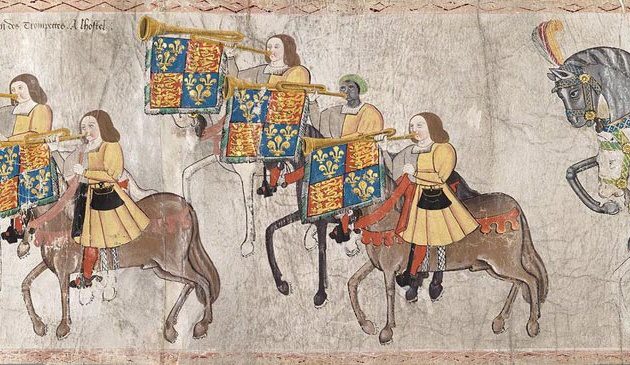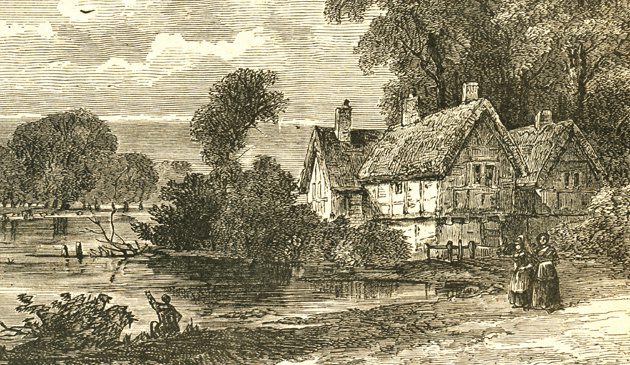The Tudor Whitehall Palace

Whitehall Palace at the time of Queen Elizabeth, shown in Ralph Agas’s Civitas Londinium map. The palace spans both sides of The Street, the two sides joined by the Holbein and King Street gates. The royal apartments and Privy Garden are to the east of The Street, with the private Privy Stairs providing access to the river. North of the Holbein Gate are the Tilt Yard and Scotland Yard.
There had been a royal palace at Westminster since King Cnut in the early 11th century but a disastrous fire in 1512 led Henry VIII to abandon it as a royal residence. The fall from grace of Cardinal Wolsey, and the creation of St. James’s Park as a new hunting ground, gave Henry the opportunity to establish a new royal palace close by.
The great hall at Westminster was built by William II, son of the Conqueror, and completed in 1099 and during the following 400 years various monarchs made changes and additions. Although other royal palaces were established, and monarchs moved between them, the Royal Exchequer settled at Westminster. It therefore became the principal royal palace of English monarchs and home of the royal administrators. But in 1512 the royal residence was largely destroyed by fire and Henry VIII found himself as the first monarch since Saxon times without a palace at Westminster.
During the time of King John and the early reign of Henry III one of the most powerful men in the country was Hubert de Burgh. It was important for him to have a residence close to Westminster. In 1221 he married the sister of the King of Scotland. Shortly after purchased from Westminster Abbey a complex of houses at Westminster on King Street, which ran parallel with the Thames, north from Westminster to the hamlet of Charing. Hubert then acquired additional adjoining properties.
De Burgh eventually fell from grace and in 1241 his property at Westminster was sold to Walter de Gray, Archbishop of York. In 1245 it was given to Walter’s successors as archbishops, who used it thereafter while attending the royal court, and it became known as York Place.
Thomas Wolsey, the son of an Ipswich butcher was a local priest who rose to become Henry VIII’s almoner. He achieved prominence amongst Henry’s ministers by supporting the King’s war against France and became Henry’s trusted advisor. In 1514 he was made Archbishop of York. In the following year the Pope appointed him as a cardinal, and Henry promoted him to Lord Chancellor.
During the fifteen years of his tenure, Wolsey transformed York Place into a magnificent palace, rivalled only in the London area by the Archbishop of Canterbury’s Lambeth Palace. Its walls were hung with cloth of gold and silver. He employed a large staff and entertained lavishly, with sumptuous banquets and elaborate masques. One occasion of note was on All Hallows Day in 1527 when Wolsey hosted a banquet for King Henry and the French ambassadors. It was attended by eighty dignitaries, following a mass as St. Paul’s Cathedral to solemnise the peace treaty between England and France that Wolsey had negotiated.
A Great Hall, the Long Gallery, the Great Chamber with a wine cellar below, and a chapel, were all added by Wolsey, as well as an orchard. York Place was enlarged when Wolsey purchased neighbouring tenements. That included Scotland Yard to the north of York Place, where Scottish kings had lodged during the Middle Ages when paying homage to the English monarch. (The original headquarters of the Metropolitan Police was located at Scotland Yard in the early 19th century).
By 1525 Henry looked for ways to annul his marriage to Catherine of Aragon so he could marry Anne Boleyn. Wolsey failed to obtain approval for the annulment from the Pope and in 1529 was stripped of his government office and properties.
For the time being Wolsey remained Archbishop of York and for the first time visited Yorkshire. While there in 1530 he was accused of treason, for which punishment would be execution, and ordered back to London. During the journey he died at Leicester.
Henry had been a frequent guest of Wolsey at York Place. Since the fire at the Palace of Westminster he had most frequently stayed and entertained at Greenwich Palace. With the Cardinal’s fall from grace the nearby York Place would make an ideal replacement for his former palace at Westminster. Thomas Cromwell undertook a complex series of transactions that transferred the majority of Westminster to the King. Despite being the property of the See of York, rather than the personal property of Wolsey, York House was acquired by Henry in February 1530. He renamed it Whitehall Palace, a common name in the past for stately buildings.
To the west of Whitehall Palace was land belonging to the St. James’s leper hospice, and beyond that Westminster Abbey’s Manor of Hide stretching away to Kensington. In 1536, during the Dissolution of Monasteries, Henry confiscated those extensive lands to form an enormous hunting park adjoining the palace.
The area immediately to the west of the palace was then used to create a tilt yard for jousting (which in a later time would become Horse Guards Parade), tennis courts, and a bowling alley. Cockfighting was an entertainment until the reign of Charles I in the 17th century. An octagonal cockpit was created, surrounded by a ring of seats, with specific seats for the King and Queen.
Despite the extensive rebuilding under Wolsey, Henry found Whitehall insufficient for his needs and set about enlarging and rebuilding the palace. Work on the first phase of the reconstruction began immediately so that it could be completed in time for Henry’s marriage to Anne Boleyn. Various parts of the former York Place, as well as some neighbouring houses, were demolished. Building materials were brought from the Cardinal’s college at Ipswich. Royal apartments along the riverside were centred around the Long Gallery, also known as the Privy Gallery. It was formed by bringing a new timber-framed gallery that had been built for Wolsey at Esher. Henry commissioned Holbein to paint a fresco on its walls to commemorate the achievements of the Tudor dynasty.


